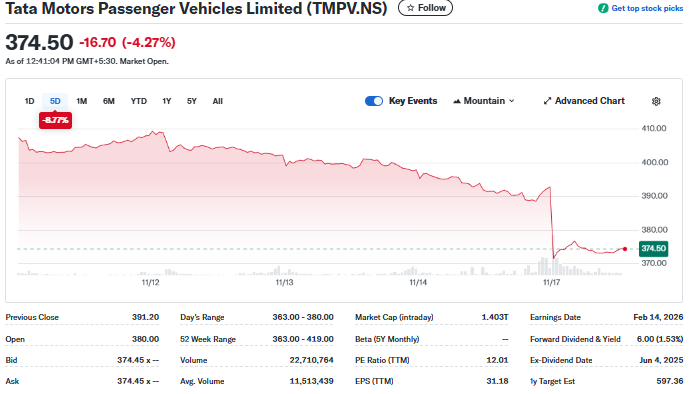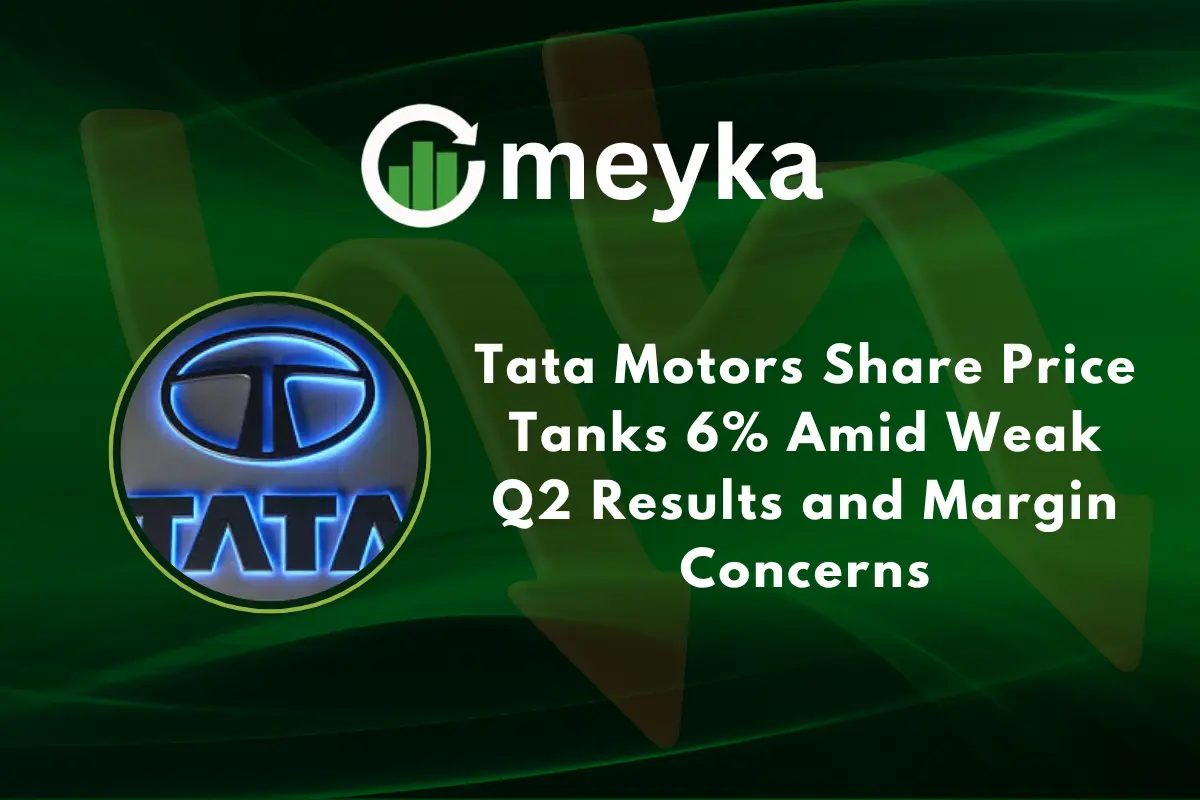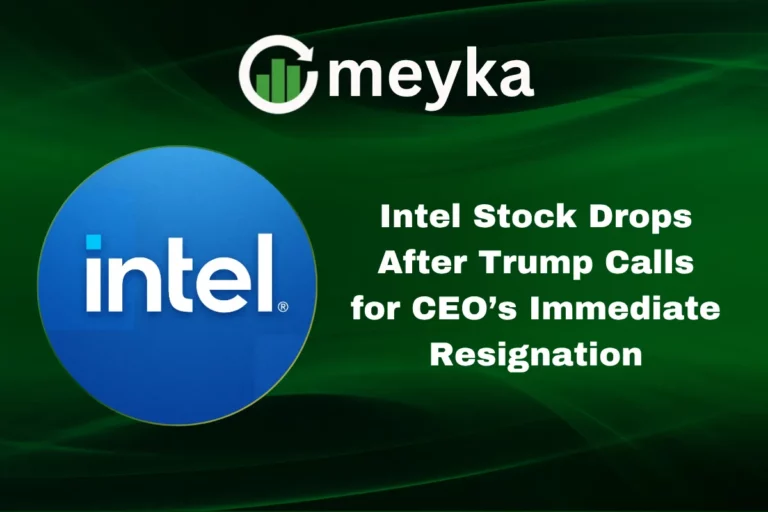Tata Motors Share Price Tanks 6% Amid Weak Q2 Results and Margin Concerns
Tata Motors entered the spotlight again when it released its Q2 FY26 results on October 24, 2025. The update drew strong reactions across the market. Many investors were watching this quarter closely because the auto sector has been facing cost pressure, slower demand in some areas, and higher competition. The results added new questions about the company’s near-term outlook.
The market reacted quickly after the announcement. The Tata Motors share price faced selling pressure as traders tried to understand the signals hidden in the numbers. Even small changes in margins or demand can shift investor mood, and this quarter was no different. Some analysts said the results showed early signs of stress, while others felt the challenges were temporary.
This article breaks down the key points from the Q2 FY26 report. It explains what drove the market reaction, what concerns came up, and what the trends mean for the months ahead.
Overview of Tata Motors’ Q2 FY26 Performance
For the quarter ended September 30, 2025 (Q2 FY26), Tata Motors posted mixed results. The newly demerged passenger vehicle arm, Tata Motors Passenger Vehicles Ltd (TMPV), registered a massive reported profit of about ₹76,170 crore, boosted by a one-time gain linked to the demerger of its commercial vehicles business. However, excluding that exceptional gain, the underlying business showed a loss of roughly ₹6,370 crore.

Revenue for TMPV fell about 13% year-on-year to ~₹71,700 crore. On the commercial-vehicle side, the demerged unit of Tata Motors recorded a net loss of ₹867 crore, even as revenue rose ~6% to ₹18,585 crore. A key drag for the group was the luxury arm Jaguar Land Rover (JLR), where wholesale volumes fell around 24.3% in the quarter and margins turned sharply negative.
Using an AI stock research analysis tool revealed that the margin erosion and one-time items are likely to weigh on full-year performance unless turnaround actions are swift.
What Triggered the ~6% Fall in Tata Motors Share Price?
On November 17, 2025, TMPV shares dropped nearly 6% at market open, reflecting investor unease over the reported results.
The main triggers were the steep profit miss (when excluding the one-time gain), the large loss at JLR, and a sharp cut in guidance for JLR’s full-year EBIT margin to just 0-2%, down from earlier targets of 5-7%.

Another worry was the cyberattack at JLR in September, which halted production for several days and disrupted supply chains. The market interpreted these signals as pointing to a slower recovery and a higher risk. As a result, many analysts flagged output, margin, and cash-flow concerns.
Margin Pressure and Cost Challenges
Margin pressure is the critical issue. At JLR, the margin collapse stems from the scale of production disruption, increased raw-material cost, and lower pricing power. The shutdown due to the cyber incident directly cut volumes, which lifted the fixed-cost burden.
In the Indian operations, despite stable demand in some segments, discounting and channel inventory pressure weighed on profitability.
TMPV’s domestic EBITDA margin fell to about 2.4% in Q2 FY26 from ~5.8% a year earlier.
Cost inflation, transition to EV/CNG models, and supply-chain complexity are adding to the headwinds. Until margins stabilise, the business remains under threat of further erosion.
Segment-Wise Breakdown
JLR (Jaguar Land Rover)
JLR is the single largest profit driver within Tata Motors, but it underperformed badly in Q2 FY26. Wholesale volumes dropped 24.3% and revenue slumped.
The firm now expects FY26 EBIT margin of just 0-2%. Investors are sceptical because the business is burning cash. JLR warned of a free cash outflow of £2.2-2.5 billion.
The cyberattack, model-phase-out of legacy Jaguars, US tariffs, and weak China demand added layers of risk.
Passenger Vehicles (PV) – India
In India, TMPV recorded a revenue drop of ~13 % in Q2 FY26 to ~₹71,700 crore. The business reported a loss after excluding the one-time gain. Domestic operations showed resilience in EV and CNG uptake, with EVs up ~60% year-on-year, though base volumes remain under pressure. Margins in India were small, but the business holds potential if EV/CNG scale and cost structure improve.
Commercial Vehicles (CV)
The CV unit showed a ~6 % revenue increase in Q2 FY26 (~₹18,585 crore), but still posted a net loss of ~₹867 crore. Although the margin improved marginally (EBITDA margin around 10.8%), full profitability remains elusive amid slower freight growth and high input costs. The CV business may be steadier than JLR, but it lacks explosive growth prospects.
Investor and Market Reactions
Market sentiment turned cautious fast. Analysts cut target prices and downgraded outlooks. For instance, one major brokerage put a “Underperform” rating on TMPV with a target of around ₹300. Another kept “Neutral” with a target of ~₹365, citing the depth of the JLR shock. Some more optimistic ones retained “Outperform” but flagged high execution risk.
Institutional investors are watching cash flows, margin recovery, and the next two quarters very closely. The immediate share-price drop shows the market’s verdict: weak results + weak outlook = weak sentiment.
What does this mean for Tata Motors Investors?
The current situation signals caution. The profit drop and margin concerns mean that near-term upside is limited.
Key upside catalysts still exist:
- A full recovery at JLR, when volumes climb and margins recover.
- Strong growth in EV/CNG segments in India, which could offset weakness elsewhere.
- Cost-cutting and operational improvements across the group.
But risks are significant:
- Global demand slowdown, especially for premium vehicles.
- Continued margin pressure from raw materials and supply chain issues.
- Execution risk in new product launches and business transitions.
For long-term investors, the story remains “optional upside with risk.” For short-term traders, the caution flag is waving. Using an AI stock research analysis tool suggests that unless margin stabilisation happens by Q4, the stock may experience further downside or sideways movement for some time.
Wrap Up
In Q2 FY26, Tata Motors delivered a dual performance: a headline profit for the passenger-vehicle arm thanks to one-time gains, but underlying operations remain under stress. JLR’s problems dominate the narrative and weigh heavily on the group’s future.
If JLR recovers and India operations gain scale in EV/CNG, the company could turn the corner. Until then, the risks remain front and centre. Investors must watch margins, cash flows, and external demand closely. The 6% share-price fall on November 17, 2025, shows just how sensitive the market is to any sign of weakness.
Frequently Asked Questions (FAQs)
Tata Motors’ shares fell nearly 6% on November 17, 2025, mainly due to weak margins, JLR losses, and a lower profit outlook in the Q2 FY26 report.
In Q2 FY26, Tata Motors reported a one-time gain for passenger vehicles but underlying losses, lower revenue, and JLR margin pressure. CV revenue rose slightly.
After Q2 FY26, Tata Motors shows both risks and potential. Investors should watch margins, JLR recovery, and EV growth before deciding, keeping market volatility in mind.
Disclaimer: The content shared by Meyka AI PTY LTD is solely for research and informational purposes. Meyka is not a financial advisory service, and the information provided should not be considered investment or trading advice.






